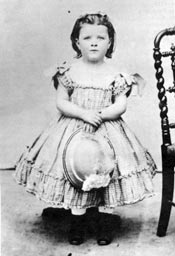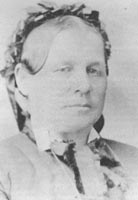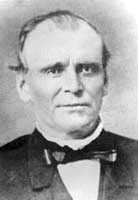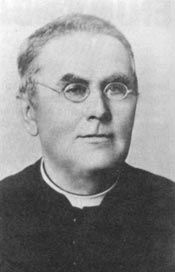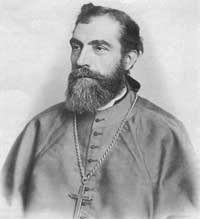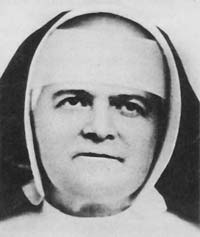|
|
Alodie Virginie Paradis was born on May 12, 1840 in the little village of L'Acadie, in the county of St. Jean de Quebec. She was the third of six children and although she was given the name Alodie when she was baptized, she was always called "Élodie". Her parents were Joseph and Émilie Grégoire, who married in 1837. They were very staunch Catholics who raised their children in the fear and love of God. Her mother was a happy, pious and extremely charitable woman, and Élodie inherited all of these good qualities. Her greatest quality was that she could not tolerate the sufferings of others around her, and that she was happy only when she saw that others were happy! Young as she was, the little girl would often go to church with her grandfather. There she would sit beside him and pray before the tabernacle and in front of the altar of Our Lady. In 1845, when Élodie was only five, her family moved to St. Philippe. Mr. Paradis was forced to move, because he needed more money to sustain his family. Here he rented an old mill situated on the edge of La Tortue River. He was now able to make a better living: sawing timber, grinding grain and carding wool. His loving wife continued to practice her great charity towards others and often fed clients who came from distant places. It was by observing such charity that little Élodie learned to be sensitive to the needs of others.
Often during these years Émilie would ask Élodie to pray to Our Lady for the family's pressing needs. She would ask Élodie to go to her room to beg Our Lady and St. Anthony to find some lost object, but after a certain time if someone forgot to call her, she would cry out, "Maman have you found your needle?" or "Have you obtained the favor?" If the favor had not been obtained, little Élodie would continue praying, and if the favor had been obtained, she would rush down the stairs. Both parents loved Élodie very much and had to make a big sacrifice when the time came for her to go to school. The nearest school was only a mile away, but Mme. Grégoire wanted her daughter to be educated in the boarding school that was run by the Sisters of the Congregation of Notre Dame, at Laprairie. When Émilie found it impossible to visit Élodie, her father would go to see her. He was very sensitive to the wishes of his little daughter when he found out that she was homesick. At these times he would often tell her, "You're going to come back home, my Élodie; you are so young and your mother and little brothers miss you terribly!" Then an hour later, a victorious father would place the little girl into the arms of her dear mother. On these occasions, Élodie’s mother always welcomed her warmly. If she arrived around lunch-time, the girl was given a hearty meal. But make no mistake! Soon as the meal was finished, Émilie would take her back to the boarding school. If Élodie happened to arrive in the evening, she would have supper with the family and spend the night at home. The next morning, Émilie would take her little girl back to the boarding school. But after awhile, Élodie was no longer homesick; she loved being at school with the good Sisters. In 1849, the Paradis family moved to Napierville to live with Émilie’s father, and Mr. Paradis left for California, in search for gold, hoping by this means to support his family. Élodie now had to go to the village school in Napierville. During this time, she also prepared for her First Communion. She now lived too far away from her grandfather's home and had to carry her lunch to school. Some nosey classmates noticed that Élodie was often missing at the noon meal and discovered that she would give her lunch to some poor children and then go to the nearby church to spend her lunch hour. But the pastor put a stop to this, as he wanted Élodie to eat her lunch too.
Mr. Paradis had been away for a long time, so in 1852, Mme. Paradis and her children returned to the village of St. Philippe, in the region of La Tortue. In July that year, Mme. Paradis set out on a pilgrimage to the church of St. Anne de Varennes, to pray for her husband. She also took her oldest son and Camille Lefebvre, a family friend. After visiting the sanctuary, the three tired pilgrims stopped at an inn to rest. Camille noticed an edition of the Montreal newspaper and read that the Holy Cross Fathers, who had recently come to Canada, were offering courses in philosophy and theology. Those taking the courses would also be able to attend day classes at St. Laurent College. This news was St. Anne's answer to his prayer and a few days later he left for St. Laurent. Later he would become a Holy Cross Father and founder of the Memramcook House of Sisters, in New Brunswick. And from this very house he would call upon a group of religious women to form the Congregation of the Holy Family! St. Anne also answered the prayers of Mme. Paradis. When she returned home, she received a letter and a large cheque from her husband. In January 1854, Camille Lefebvre went to visit his mother and the Paradis family. He described the Sisters of the Holy Cross at St. Laurent to Élodie, in such an attractive manner and she immediately requested admission to their Order. On Feb 21, 1854, Mme Paradis took thirteen year and month old Élodie to the Sisters of the Holy Cross. Élodie entered the Novitiate and one year later in 1855, she received the white veil of the Novices; she was now Sr. Marie of St. Léonie, but better known as Sr. Léonie. She spent the second half of her Novitiate in the convent at St. Scolastique. Here she had a good Mother Superior who had been her "Guardian Angel", when she was a Postulant. Of this time, this Mother Superior writes that Sr. Léonie was an, "energetic soul, capable of doing the Holy Will of God," with a "noble and generous heart"! In 1857, Sr. Léonie returned to the convent in St. Laurent. During this same year she underwent a very great trial! Mr. Paradis had returned to St. Philippe and started up his mill at La Tortue but he found life at home impossible without his daughter, Élodie. One day he appeared in the parlor at St. Laurent; determined to bring his daughter back home. The Superiors protested and Élodie protested with arguments and tears, but Mr. Paradis would not relent. Sr. Léonie ran to the statue of Our Lady, and in tears begged Mary to make her die rather than let her be torn away from the convent. Suddenly she began to haemorrhage in her lungs and to spit blood! Frightened for her health, and seeing that God had intervened, Mr. Paradis returned home. As the months passed, Sr. Léonie came closer and closer to the day of her religious profession; but she was faced with two problems, first she was in poor health; the Superiors were worried about her health and they refused to allow her to take her vows, and second, she was very young. In August 1857, Fr. Basile Moreau the founder of the Fathers, Brothers, and Sisters of the Holy Cross, arrived to make a ten day canonical visit to the Sisters of the Holy Cross in St. Laurent. During this visit an elderly Sister encouraged Sr. Léonie to speak to Fr. Moreau saying, "Go to see him with confidence. Go, our Father Founder can not resist tears!" After having cried and beseeched Fr. Moreau for an hour, Sr. Léonie obtained his approval for her to make her vows with two of her companions on August 22, 1857. Fr. Moreau presided at the ceremony and of this time Élodie says, "Never could I or many others, explain the happiness I felt that day." As a newly professed seventeen year old sister, Sr. Léonie was assigned to Varennes, the sight of the sanctuary so dear to her mother. Here she taught young students, supervised the study or recreation rooms when she was sick, and was her Superior's secretary. A year later she carried on the same work at St. Laurent and after that she did the same at St. Martin. In 1862, the American Branch of the Holy Cross Sisters accepted a very complex work in New York. It was to take care of an orphanage, a school, and also a workroom, in favor of the poor. But as many poor French children were also scattered throughout New York, the Sisters asked the Canadian Province to “lend” them some French Sisters. With some companions Sr. Léonie was sent there and devoted eight years of her life to that work. But in 1870, when the Superior of the New York Convent was deposed and left the Order, feeling at a loss, Sr. Léonie returned to St. Laurent where she lived through two months of doubt and agony. Finally, she got a glimpse of hope: she asked for admission within the American Sisters of the Holy Cross. She was authorized by Rev. Fr. Sorin, second Superior replacing Fr. Moreau. So she was to go to Indiana, at the little village of Notre-Dame-du-Lac. She was later sent a few miles away to teach French and needlework to the girls attending St. Mary’s. Sr. Léonie was such an expert teacher and prudent counsellor that for three years, she was elected to be part of the chapter of her Congregation. During this time Sr. Léonie’s first desire was to save her former New York Superior, who was back in the world since 1870. Since the Generalate of the Institute refused to re-admit the former Superior, back into the Order, Sr. Léonie begged Fr. Sorin to allow her to come back. But it wasn't so easy, it would take six years of praying and pleading and tears before Fr. Sorin would finally agree to grant saintly nun’s request. Also during this year, Sr. Léonie’s beloved father died; the memory of the love he had for her as well as the times he would take her home from boarding school, would always remain with her. Sr. Léonie knew that God had His reasons for taking her Papa away and she bowed to His Holy Will. In 1874, Fr. Sorin decided to send thirty-four year old Sr. Léonie, to the Holy Cross Sisters in Memramcook, New Brunswick. When she arrived, accompanied with another Professed Sister, she was overjoyed to find that her childhood friend, Fr. Camille Lefebvre, was there and was now the Provincial Superior of the Holy Cross Congregation! Fr. Lefebvre was responsible for the new foundation of Memramcook and he was also in charge of the parish and a small French college for the Acadians. Sr. Leonie was appointed Superior of the little community composed also of four English Novices who came earlier from Indiana, and a few local Acadian Postulants. All the members of this community busied themselves with the domestic tasks at the college. They lived in poverty without the conveniences of an organized convent. Their living area was half of one of the old rectory floors. The other half of the floor served as an infirmary for the college students. At night, straw mattresses were spread less than a yard apart on the floor and in the morning they were piled up in a corner so that the dormitory could be used as a workroom. The first floor was used as a laundry room, and a small room transformed as a chapel. The refectory, the parlor, and Sr. Léonie’s small room and office were in a part of the new Rectory. The winter of 1874-1875, Sr. Léonie’s first in New Brunswick, was one of hardship and suffering. She now had the responsibility of leading her community and guiding their souls, but she did not have the help of Fr. Sorin! She struggled and with God's help she succeeded. The first four Acadian Postulants in Memramcook took the habit on the Feast of St. Joseph, 1875. But Sr. Leonie, away from Quebec since 1862 was now homesick. She asked Fr. Lefebvre, if she could go to Montreal to buy some flower seeds. At first he refused her request while laughing heartily, and Sr. Léonie understood she was being childish and forgot it. But realizing that she was homesick, the next day he gave her permission to go, assuring her, "You will go to Montreal; I have urgent messages that you will deliver. I am happy to have found someone who will do this for me." And the end result was that Sr. Léonie had a most beautiful garden at the convent in New Brunswick.
Young Acadians continued to flow into the new community and in September 1875, Sr. Leonie was bringing eight new Postulants to Indiana when she stopped at Montreal. Fr. Gastineau, Rector of the Notre Dame College of Cote-des-Neiges asked her to give him one of her Postulants to help him with some other girls that Fr. Lefebvre had left there in his trip of last July. Fr. Lefebvre’s idea had been that these girls would pay for their trip and their dowry by working at the College, and then they would go to Indiana. But as they were not really trained yet, their work and prayer life were far from perfect. Therefore Fr. Gastineau needed more help. He even begged Sr. Léonie to pay a visit to Archbishop Fabre of Montreal, and to ask his permission to bring back girls from Indiana. But the holy Bishop didn’t want any rivalry to be started between the American and the Canadian Branches of the Congregation, he was at a loss of what to do. But then he got an idea and asked her: “Well, Sister, why would you not found a small community for the service of colleges?" The seed was now planted in Sr. Leonie's heart and after thinking for a few moments she answered, "The idea is excellent Your Excellency, I will transmit it to Fr. Lefebvre." Sr. Léonie then again left for Indiana and a few weeks later returned to Memramcook and rendered a detailed account of her long voyage to Fr. Lefebvre, but he did not seem to attach much importance to the found-in of a new community. Sr. Léonie spent her second winter in Memramcook and trusting in Divine Providence, continued to form the young girls' souls under her care, in the way of virtue. In January 1876, the students took possession of a new stone college built by the tireless Fr. Lefebvre and the old wood college was given to the Sisters; now they could live a decent community life. But in July Fr. Lefebvre, back from a General Chapter held in France, and that had treated of the necessity to have some nuns dedicated to the domestic tasks at the Colleges run by the Fathers, encouraged Sr. Léonie towards grouping some “Auxiliaries” around her in a workroom. The group of six Postulants that were already working in Montreal would follow a rule set by Sr. Léonie, and would be part of that new “group”. She accepted, and received eight Acadian girls in her workshop, giving them an initiation to the religious life. On August 27, 1877 fourteen young Acadian girls finished their postulancy, and were reunited in Memramcook to be in a new uniform that would mark their union of heart and of apostolate, as well as the beginning of their noviciate. But no sooner had it begun; the new Institute was subjected to much contradiction. Public opinion called the Institute a Third Order of the Holy Cross, founded without permission. In Montreal, even Archbishop Fabre who had favored the foundation; opposed the project. On arrival of the group of Little Sisters in their new uniform, he asked them to refrain from wearing their new uniform, or leave the Holy Cross Institute! The Little Sisters then began to wear a cotton hood as worn by country girls and they wore a black dress with a black veil, when they entered the city. Indeed, the first Acadian Sisters went through their Novitiate in the battlefield! They were endowed with a spirit of sacrifice, self-denial and dedication. And this spiritual uniform was indeed of much greater value than their newly designed uniform. In the winter they were sometimes obliged to shake their blankets in the morning, so as to get rid of the snow that had entered the house through the cracks in the wall. Sr. Léonie bore all the crosses, which burdened her spiritual daughters, and also carried her own in silence and resignation. In Memram-cook, the teaching staff of the college began to find fault with this new community, and to accuse the “Auxiliaries” to be too numerous and to jeopardize the economics of the College: God was purifying His servants and Léonie’s chalice of bitterness was gradually filling up.
But the work of the Montreal “Little Sisters” was so much liked by the Priests, that they asked for more of them for another college. So in the spring of 1878, Sr. Leonie accompanied six young Acadians from her workroom to the St. Césaire of Rouville College, run by the Fathers and Brothers of the Holy Cross. For six weeks, Sr. Léonie remained in St. Césaire, helping the Little Sisters to settle in their new surroundings. She gave spiritual lectures to the community and watched over their exercises, always lending a helping hand and encouraging them in their work. She put a straw hat over her veil, and with pick and shovel, near the convent; she planted a garden with flowers and vegetables so that the Sisters would have good food to eat. The following year in 1879, four Little Sisters were sent to the college in Farnham, run by the Congregation of the Holy Cross. On their arrival, Sister Poverty joined these four nuns: they were given a room that was unheated during the winter, and for washing and cleaning, they often had to haul water from the nearby river. They made many sacrifices and these sacrifices formed a much stronger foundation, than stone! With three foundations outside of Memramcook, authorities were still not convinced about all the good that the Little Sisters were doing. Bishop Sweeny of St. John, New Brunswick, maintained a reserved attitude towards these nuns and even suggested to Sr. Léonie that she affiliate her nuns with the Sisters of the Holy Cross, in Indiana. Sr. Leonie went to Indiana three times for this purpose but to no avail. In the spring of 1880, a General Chapter of the Religious of the Holy Cross was held in France, and Fr. Sorin himself defended the cause of the “Auxiliary Sisters”. Fr. Lefebvre was then authorized to write and present to the Sisters the decree of foundation of the new Community. He did so on May 31, 1880, and the Sisters were placed under the patronage of Jesus, Mary, and Joseph and called “Little Sisters of the Holy Family”. Institution was recognized and documents were signed; now the Sisters were known as the "Little Sisters of the Holy Family". But Sr. Marie Léonie was to remain in the Institute of the Holy Cross Nuns. It is therefore with profound sadness that she saw four of the five original Holy Cross Sisters go back to Indiana in 1882. nevertheless she continued to send Postulants there, while also taking care of the “Little Sisters”, that con-tine to grow in numbers at her workroom. And some trouble was to come soon from these Auxiliaries. Indeed, in 1883, there was a beginning of a revolution within the community. Some Sisters wrote to Fr. Lefebvre to tell him about some defects they found in Sr. Léonie (lack of tact, untidiness, etc…), and to ask him to send her back to Indiana, and to name a Superior chosen from among the Little Sisters them-selves. What a shock when the good Father showed the letter to Sr. Léonie, who had just come back from visits to Montreal, St. Césaire and Farnham, and had praised her Sisters for their good spirit! Of course, Fr. Lefebvre kept her a Memramcook, and put the order back among the Little Sisters. But despite all this, vocations con-tined to grow! In 1886, the Little Sisters were asked to establish a fourth convent in Sorel, Quebec, where the Holy Cross Fathers had just founded a college. Also during this same year, Mme. Paradis who sometime before had married a second time; lost her husband. Being a widow again, she joined Sr. Leonie as a retired border, a great consolation for the saintly nun, in the midst of her trials. But Human joys do not live long! In August 1893, Mme. Paradis died. The Little Sisters were greatly saddened at losing her, for they had greatly loved and revered her. Sr. Léonie assisted her mother during her last agony and closed her eyes in death. Also at this time, Sr. Léonie sent some Little Sisters to Maine: their first community in the United States. Here they assumed the responsibilities of serving the priests at the Marist Fathers College. In April 1894, Sr. Léonie had a serious case of bronchitis, complicated by ulcers. The doctors could not cure her and death was imminent. Fr. Lefebvre promised that if she were cured he would lead a pilgrimage in thanksgiving to the Queen of the Holy Rosary, at Cap de la Madeleine. Our Lady cured Sr. Léonie and during the month of June, she and another Sister made the pilgrimage with the Fr. Lefebvre, to Our Lady's shrine. On January 26, 1895 Fr. Lefebvre came to the Convent of the Little Sisters of Memramcook. He told the sacristan, "Get the missal for me. I have brought you the Mass of the Holy Family and I wish to insert it into the missal myself. How happy I am! Tomorrow I shall say this Mass for the first time." While saying Mass the next morning the priest's heart filled with joy. This joy was spread amongst the Little Sisters but it did not last long because that very night, Fr. Lefebvre died. The Holy Family took him on their Feast Day, a fitting time for the priest who had done so much to help the Little Sisters of the Holy Family. But now, the young Community had no protector on this earth. On June 24, 1895 Bishop LaRocque of Sherbrooke, Quebec had an interview with Sr. Léonie at Memramcook. His great desire was to obtain a group of religious woman who would take charge of the domestic services at the Episcopal Palace, and at St. Charles Borromeo Seminary. Furthermore, he wanted the Novitiate to move to Sherbrooke. He promised her to give the young Institute his canonical approval! Our friend, having received the approbation of the Holy Cross Fathers, and of the Bishop of St. John, accepted the mover. Later that year he sent Sr. Léonie a letter of welcome: "I hope you will like my dear Sherbrooke…. And I hope that your dear Sisters will not be unhappy here. They won't have wealth here; the Bishop himself is poor because he leads a diocese where many of the parishes are only missions…" By August of the same year there were a total of ninety Little Sisters in the Institute. During that month four Sisters arrived at Bishop LaRocque’s residence in Sherbrooke. Illness prevented Sr. Léonie from accompanying them to their newest foundation. It wasn't until October 5, 1895 that Sr. Léonie was finally able to move to Sherbrooke with one Professed Sister and four Postulants, and it was with a heavy heart that she did so, because she was extremely attached to the Little Sisters of Memramcook and they were greatly attached to her. The Rector of the diocesan Seminary lent the little group a small house near the Episcopal Palace. On January 24, 1896 Sr. Léonie, who was then visiting Memramcook, received a telegram from Bishop LaRocque: "Rev. Mother Leonie. Pastoral letter authorizing canonical establishment of Community, signed. Date: Feast of the Holy Family. Give thanks to God. Paul, Bishop of Sherbrooke." Now Sr. Léonie, who had been the "Mother" of her spiritual daughters for so many years, could rightfully be called, "Mother Leonie!" On January 26, 1896, the Feast of the Holy Family was celebrated with much joy and thanksgiving by the Little Sisters at Memramcook and Sherbrooke, and in all their missions. In August 1896, the Little Sisters set up new foundations at the Levis College and at the Sacred Heart Juniorate in Ottawa. And in September of that year, the Little Sisters in Sherbrooke moved into their new Motherhouse near to the seminary. As the years passed the Little Sisters of the Holy Family grew by leaps and bounds. God was pleased with their dedication to serving priests and in 1904; there were four hundred Little Sisters throughout their missions, in Canada and the United States. In May 1904, Mother Léonie had the great joy of assigning four Little Sisters to help at the monastery of the Missionary Oblates of Mary Immaculate at Cap de la Madeleine. Bishop LaRocque had expressed the desire that Sr. Léonie adopt the new habit of her spiritual daughters. On October 7, 1904 Mother Léonie, now sixty-four years old, dawned the habit of the Little Sisters of the Holy Family. As she removed the old habit she had worn for almost fifty years, with all its attachments, she wept as she pressed each piece to her lips: the image of Mary, the blue cincture, the rosary and finally the habit itself, saying "… I humbly submit to His (God's) Holy Will despite the sacrifice it requests of me." In 1910, at the age of seventy, Mother Léonie continued working and traveling, but she was slowly wearing out. In May 1911, she wrote a letter to one of her communities, "I am aware that I have aged very much. I am losing my memory, my sight and my hearing, and now my hand shakes as I write." But in spite of this, on March 19, 1912 Mother Léonie was at St. Joseph's Oratory to establish another mission; it was to be her last. On May 3, 1912 she heard Mass and had breakfast with the community. Later she made a few corrections in the book of rules and then said the rosary. She ate supper and returned to her room with two of her secretaries, but she was so tired that she decided to lie down. Suddenly she grew pale; a doctor and a priest were called, but to no avail! Mother Léonie died peacefully while the priest was anointing her. She had lived 72 years on this earth, leaving us with an example of holiness lived day by day, in a life that seems at first glance plain, but which was full of merits and fruits. She has been declared “Blessed” by His Holiness Pope John-Paul II on September 11th 1984, while he was in Montreal, on his Canadian trip. Mother Marie Léonie was always resigned to God’s Holy Will. She wrote, "Whenever I get news that saddens me, I say God permits this. God is giving me a little slap. Without this, like a mother who is proud of her children, I would become too proud of the great virtues of my Sisters." Her deep faith, made her see the hand of God in everything. Everything in creation that caught her eye elevated her soul to God: a flower, a singing bird, a beautiful landscape, a sunset and even the winter storms inspired her to sing praises to God. She had a profound devotion to Jesus in the Blessed Sacrament and made countless visits to the Bread of Life.
Mother Léonie also had a great devotion to Our Lady of Sorrows and Our Lady of the Rosary. She had all of her daughters join the Confraternity of the Holy Rosary and was often seen praying Aves on her rosary to and from the chapel, in the hallways and elsewhere. And Mother Léonie didn't forget about good St. Joseph either. She put all the temporal affairs of the community into his hands and said, "I began my work empty handed, counting solely on Divine Providence and on St. Joseph. This good saint can well be called the support and protector of this enterprise, as of Mary and Jesus." What a lovely
example of holiness our dear Mother Léonie is. Let us all
take her good words to heart and keep them there, "Let
us work... while we are on earth because this is all God asks
of us. There is no better prayer that we could offer Him than
our dedication to work. We will all rest in Heaven!"
Home | Contact
| Mass Centres | Schools
| Pilgrimages | Retreats
|
Precious Blood Residence |
|||||||||||||||||||||||||||||||||


